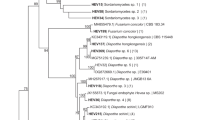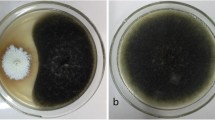Abstract
Endophytes that live with plants in a mutualistic symbiosis can be promising biological agents to improve biotic resistance. In this study, 157 endophytic fungi isolates were obtained from from root, stem, and leaf segments of E. japonicus, and they were grouped into 2 phyla, 4 classes, 9 orders, and 26 genera based on characterization of morphological features and variances of ITS1, ITS2, and 5.8 s nrDNA sequences, the Genbank accession numbers of 79 representative endophytic fungi were from MT919117 to MT919195. Of 157 islotates, Ascomycota (99.4%), Sordariomycete (64.3%), Hypocreales (26.8%), and Colletotrichum (14.7%) were the most abundant phylum, class, order, and genus, respectively. The isolation frequency, Species richness(S), Shannon index of diversity (H`) was significantly higher in root than in stem and leaf. Among them, 15 strains exhibited various levels of antagonicstic abilities against two major pathogens, Colletotrichum gloeosporoides and Neopestalotiopsis foedans of E. japonicus, and three others of Botrytis cinerea, Phomopsis sp. and Botryosphaeria dothidea. The isolate ER15, which was classified as Trichoderma sp., exhibited the strongest level of antifungal effect with up to 70% of growth inhibition against these six pathogens in a dual culture assay. These results suggest that ER15 could have potential applications in Anthracnose and branch blight control of E. japonicus.

Similar content being viewed by others
References
Angelini P, Rubini A, Gigante D, Reale L, Pagiotti R, Venanzoni R (2012) The endophytic fungal communities associated with the leaves and roots of the common reed (Phragmites australis) in Lake Trasimeno (Perugia, Italy) in declining and healthy stands. Fungal Ecol 5:683–693
Aly AH, Debbab A, Proksch P (2011) Fungal endophytes: unique plant inhabitants with great promises. Appl Microbiol Biotechnol 90:1829–1845
Backman PA, Sikora RA (2008) Endophytes: an emerging tool for biological control. Biol Control 46:1–3
Ban Y, Tang M, Chen H, Xu Z, Zhang H, Yang Y (2012) The response of dark septate endophytes (DSE) to heavy metals in pure culture. PLoS ONE 7:e47968
Cui JL, Guo TT, Ren ZX, Zhang NS, Wang ML (2015) Diversity and antioxidant activity of culturable endophytic fungi from alpine plants of Rhodiola crenulata, R angusta, and R sachalinensis. PLoS ONE 10:e0118204
Da Silva MF, de Souza AC, de Oliveira PJ, Xavier GR, Rumjanek NG, de Barros Soares LH, Reis VM (2012) Survival of endophytic bacteria in polymer-based inoculants and efficiency of their application to sugarcane. Plant Soil 356:231–243
El-Katatny MH, El-Katatny MS, Fadl-Allah EM, Emam AS (2011) Antagonistic effect of two isolates of Trichoderma harzianum against postharvest pathogens of tomato (Lycopersicon esculentum). Arch Phytopathol Plant Protect 44:637–654
Fadiji A, Babalola O (2020) Elucidating mechanisms of endophytes used in plant protection and other bioactivities with multifunctional prospects. Front Bioeng Biotechnol 8:467
Geisen S, Kostenko O, Cnossen MC, ten Hooven FC, Vreš B, van der Putten WH (2017) Seed and root endophytic fungi in a range expanding and a related plant species. Front Microbiol 8:1645
Hamzah TNT, Lee SY, Hidayat A, Razak TR, Faridah-Hanum I, Mohamed R (2018) Diversity and characterization of endophytic fungi isolated from the tropical mangrove species, Rhizophora mucronata, and identification of potential antagonists against the soil-borne fungus. Front Microbiol 9:1–17
Han JT, Yang CP, Han XM, Liu GQ (2008) Screening of pesticidal activities of plant endophytic fungi from Euonymus japonicus. Acta Agric Boreali Occident Sin 17:98–10
Huang L, Li QC, Hou Y, Li GQ, Yang JY, Li DW, Ye JR (2017) Bacillus velezensis strain HYEB5-6 as a potential biocontrol agent against anthracnose on Euonymus japonicus. Biocontrol Sci Techn 27:636–653
Jalili B, Bagheri H, Azadi S, Soltani J (2020) Identification and salt tolerance evaluation of endophyte fungi isolates from halophyte plants. Int J Environ Sci Technol 17:3459–3466
Jain R, Bhardwaj P, Pandey SS, Kumar S (2021) Arnebia euchroma, a plant species of cold desert in the himalayas, harbors beneficial cultivable endophytes in roots and leaves. Front Microbiol 12:69667
Jin Z, Li D, Li T, Yu F, Zhang Z, Su C, Wang Y, Guo Q, Liu Z (2017) Cultural endophytic fungi associated with dendrobium officinale: Identification, diversity estimation and their antimicrobial. Potential Curr Sci 112:1690–1697
Khalmuratova I, Choi DH, Woo JR, Jeong MJ, Kim YG, Lee IJ, Choo YS, Kim JG (2020) Diversity and plant growth-promoting effects of fungal endophytes isolated from salt-tolerant plants. J Microbiol Biotechnol 30:1680–1687
López-González RC, Gómez-Cornelio S, Susana C, Garrido E, Oropeza-Mariano O, Heil M, Partida-Martínez LP (2017) The age of lima bean leaves influences the richness and diversity of the endophytic fungal community, but not the antagonistic effect of endophytes against Colletotrichum lindemuthianum. Fungal Ecol 26:1–10
Lu WD, Tian XL, Mao X, Ding W (2011) Research on the Isolation of Endophytic Fungi from Euonymus japonicus and its antibacterial activity. J Anhui Agri Sci 39:21704–21799
Naglot A, Goswami S, Rahman I, Shrimali DD, Yadav KK, Gupta VK, Rabha AJ, Gogoi HK, Veer V (2015) Antagonistic potential of native Trichoderma viride strain against potent tea fungal pathogens in North East India. Plant Patholog 31:278–289
Potshangbam M, Devi SI, Sahoo D, Strobel GA (2017) Functional characterization of endophytic fungal community associated with Oryza sativa L. and Zea mays L. Front Microbiol 8:325
Qadri M, Rajput R, Abdin MZ, Vishwakarma RA, Riyaz-Ul-Hassan S (2014) Diversity, molecular phylogeny, and bioactive potential of fungal endophytes associated with the himalayan blue pine (Pinus wallichiana). Microb Ecol 67:877–887
Rodriguez RJ, White JF, Arnold AE, Redman RS (2009) Fungal endophytes: diversity and functional roles. New Phytol 182:314–330
Yao YQ, Lan F, Qiao YM (2017) Endophytic fungi harbored in the root of Sophora tonkinensis Gapnep: diversity and biocontrol potential against phytopathogens. Microbiol Open 6:e00437
Šamonil P, Valtera M, Bek S, Šebková B, Vrška T, Houška J (2011) Soil variability through spatial scales in a permanently disturbed natural spruce-fir-beech forest. Eur J for Res 130:1075–1091
Wheeler DL, Dung JKS, Johnson DA (2018) From pathogen to endophyte: an endophytic population of Verticillium dahliae evolved from a sympatric pathogenic population. New Phytol 222:497–510
Wu F, Yang DC, Zhang LP, Chen YL, Hu XK, Li L, Liang JS (2019) Diversity estimation and antimicrobial activity of culturable endophytic fungi from Litsea cubeba (Lour.). Pers in China Forests 10:33
Yi Y, Li T, Ouyang J (2002) Species of important pests in Euonymus japonicus in western Hunan and their prevailing regularity. Forest Pest Dis 22:14–16
Zhang Q, Ji Z, Wang M, Wu W (2009) Two new insecticidal sesquiterpene esters from Euonymus japonicus. Nat Prod Res 23:1402–1407
Zhang QD, Wang MA, Ji AQ, Hu Z (2007) Sesquiterpene pyridine alkaloids from Euonymus japonicus and their insecticidal activity. Acta Bot Boreal 27:9859–863
Funding
This research was funded by the Anhui Natural Science Foundation (Grant No. 2008085MC102) and Key Projects of Anhui Provincial Education Department (Grant No. KJ2020A0517).
Author information
Authors and Affiliations
Corresponding author
Ethics declarations
Conflict of interest
The authors declare that they have no conflict of interest.
Ethical approval
This article does not contain any studies with human participants or animals performed by authors.
Additional information
Publisher's Note
Springer Nature remains neutral with regard to jurisdictional claims in published maps and institutional affiliations.
Rights and permissions
About this article
Cite this article
Song, X., Li, Y., Cao, Z. et al. Diversity assessment of endophytic fungi isolated from Euonymus japonicus. J Plant Dis Prot 129, 261–269 (2022). https://doi.org/10.1007/s41348-022-00588-6
Received:
Accepted:
Published:
Issue Date:
DOI: https://doi.org/10.1007/s41348-022-00588-6




